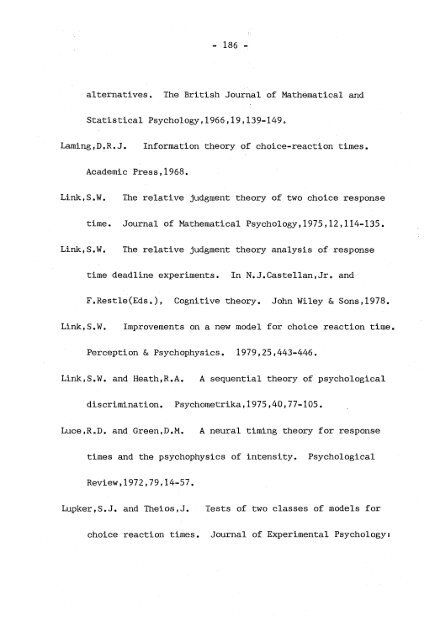A two-state model of simple reaction time
A two-state model of simple reaction time
A two-state model of simple reaction time
You also want an ePaper? Increase the reach of your titles
YUMPU automatically turns print PDFs into web optimized ePapers that Google loves.
- 186 -<br />
alternatives. The British Journal <strong>of</strong> Mathematical and<br />
Statistical Psychology,1966,19,139-149.<br />
Laming,D.R.J. Information theory <strong>of</strong> choice-<strong>reaction</strong> <strong>time</strong>s.<br />
Academic Press,1968.<br />
Link,S.W. The relative judgment theory <strong>of</strong> <strong>two</strong> choice response<br />
<strong>time</strong>. Journal <strong>of</strong> Mathematical Psychology,1975,12,114-135.<br />
Link,S.W. The relative judgment theory analysis <strong>of</strong> response<br />
<strong>time</strong> deadline experiments. In N.J.Castellan,Jr. and<br />
F.Restle(Eds.), Cognitive theory. John Wiley & Sons,1978.<br />
Link, S.W. Improvements on a new <strong>model</strong> for choice <strong>reaction</strong> <strong>time</strong>.<br />
Perception & Psychophysics. 1979,25,443-446.<br />
Link,S.W. and Heath,R.A. A sequential theory <strong>of</strong> psychological<br />
discrimination. Psychometrika,1975,40,77-105.<br />
Luce,R.D. and Green,D.M. A neural timing theory for response<br />
<strong>time</strong>s and the psychophysics <strong>of</strong> intensity. Psychological<br />
Review,1972,79,14-57.<br />
Lupker,S.J. and Theios,J. Tests <strong>of</strong> <strong>two</strong> classes <strong>of</strong> <strong>model</strong>s for<br />
choice <strong>reaction</strong> <strong>time</strong>s. Journal <strong>of</strong> Experimental Psychology:

















